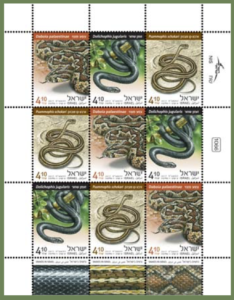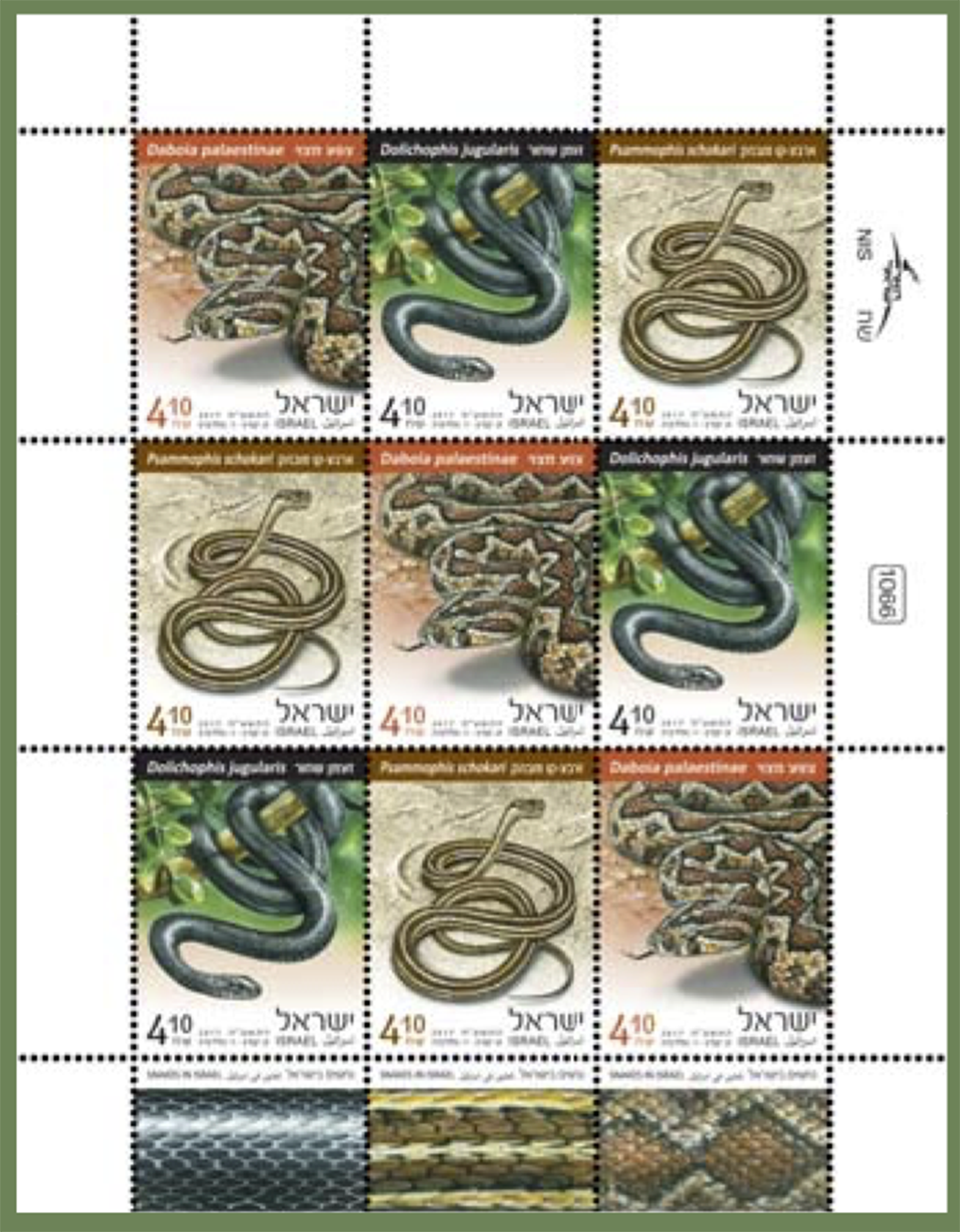From Israel Post. These stamps will be issued December 19, 2017. Larger image below.
 Israel is home to many different reptile species thanks to its location at the meeting point of three different continents and the wealth of habitats it provides. Some 100 reptile species make their homes here, among them approximately 40 species of snakes, nine of which are venomous.
Israel is home to many different reptile species thanks to its location at the meeting point of three different continents and the wealth of habitats it provides. Some 100 reptile species make their homes here, among them approximately 40 species of snakes, nine of which are venomous.
Snakes are an important component in ecological systems and in the food chain of predators and prey. They feed on arthropods, fish, fowl, small mammals and other reptiles, including snakes, each species according to its size and abilities. Snakes are preyed upon by birds, hedgehogs, mongooses and other animals.
Snakes also face other dangers – dwindling numbers of habitats, accidents with vehicles on the roads and agricultural equipment in the fields, as well as intentional harm by humans. All the snakes and other reptile species in Israel are protected by law and it is illegal to harm them. It is imperative that they are kept safe, as part of ensuring healthy ecological systems.
Schokari Sand Racer (Psammophis schokari)
Length: to 120 cm
This is a rear fanged snake, i.e. it has venomous back teeth. The venom is not injected by a quick bite but rather through a prolonged bite. Like the other sub venomous snakes found in Israel, the Schokari Sand Racer is not hazardous to humans. It is thin and fast and has a number of different attributes: in the northern and central areas of the country it most commonly has four dark lengthwise stripes against a brownish-yellow background whereas the snakes in the south have faded lengthwise stripes or none at all. There is a dark stripe along the sides of the head, beside the eyes. This is one of the only snake species in Israel that can be found throughout the entire country, from Mt. Hermon in the north to Eilat in the south. It is common in different habitats, climbs on shrubs, walls, etc. It feeds on a wide range of animals: arthropods, reptiles, birds and small rodents.
Large Whip Snake (Dolichophis jugularis)
Length: to 250 cm
The Large Whip Snake is not venomous. It is large and shiny and its appearance changes when it reaches maturity. When young, this snake is brown or grey with black and white spots. The mature snake (usually more than 120 cm in length) is completely black. In both instances, the shade of the lower jaw is lighter than the body. It feeds on different animals: reptiles, birds, rodents and more. These snakes are commonly found in agricultural areas, where their food supply is abundant, thus they are frequently killed by farming equipment. Found from Mt. Hermon in the north to the Beer Sheva area in the south.
Palestine Viper (Daboia palaestinae)
Length: to 135 cm
The Viper is venomous and the most dangerous to humans of all the snake species found in Israel, due to the potency and quantity of its venom, as well as its prevalence in inhabited areas. Its background color is yellowish, light brown or grey, with a lengthwise zigzag stripe that is brown with dark edges. Sometimes this stripe appears broken. There are additional spots on the sides of the body. This snake’s head is significantly wider than its neck and it has small scales. It is common in various habitats (including sand) in the Mediterranean region, from Mt. Hermon in the north to the Beer Sheva area in the south. It is prevalent around agricultural communities, where it is attracted to the rodents found in chicken coops, storerooms, cowsheds, etc. This Viper is responsible for the vast majority of cases in which humans are bitten in Israel. Hospitals have an antidote for its venom, which is given to the injured as needed.
Rules of Caution
In the field: high-top shoes are recommended; do not stick one’s hand into concealed places (day or night); shake out equipment and shoes after spending the night outdoors. In inhabited areas: avoid piles of pruned branches, scrap-iron, stones, etc. Keep the area clear of food scraps that attract rodents.
If You See a Snake
In the field: allow the snake to find its way by itself. Do not approach it or try to trap it. At home or in the yard: call a trained snake catcher. Keep children and animals away from the snake and try to keep it in sight until the catcher arrives. A list of licensed snake catchers is posted on the Israel Nature and Parks Authority website. Some local authorities also provide snake catching services.
First Aid in Case of Snakebite
What to do: calm the injured person, lie them down and take them to the hospital (even if he/she feels well). If the bite is on the arm or leg, it is possible to put a splint on the limb (like in the case of a fracture). Remove any rings, bracelets, watch, etc. from the injured person. If possible, take a photo of the snake.
What not to do: do not cut or burn or suck the bitten area. Do not block the blood vessels with a tourniquet. Do not put ice on the bite site, do not sterilize the spot with alcohol, do not let the injured person drink hot liquids or alcohol. Do not try to catch the snake. These guidelines do not replace medical consultation and treatment.
— Noam Kirshenbaum
Editor and Publisher, Nature in Israel



